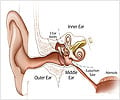Iconicity may play an important role in children's ability to learn language, researchers studying the use of British Sign Language (BSL) by young children have revealed.

But one of the first things people notice about sign languages is that signs often represent aspects of meaning in their form. For example, in BSL the sign EAT involves bringing the hand to the mouth just as you would if you were bringing food to the mouth to eat it.
In fact, a high proportion of signs across the world's sign languages are similarly iconic, connecting human experience to linguistic form.
Robin Thompson and colleagues David Vison, Bencie Woll, and Gabriella Vigliocco at the Deafness, Cognition and Language Research Centre (DCAL) at University College London in the United Kingdom wanted to examine whether this kind of iconicity might provide a key to understanding how children come to link words to their meaning.
The researchers looked at data from 31 deaf children who were being raised in deaf BSL signing families in the United Kingdom. Parents indicated the number of words understood and produced by their children between the ages of 8 and 30 months.
The researchers decided to focus on 89 specific signs, examining children's familiarity with the signs as well as the iconicity and complexity of the signs.
Advertisement
Together, these findings suggest that iconicity could play an important role in language acquisition.
Advertisement
These iconic links highlight motor and perceptual similarity between actions and signs such as DRINK, which is produced by tipping a curved hand to the mouth and represents the action of holding a cup and drinking from it.
The researchers emphasize that these results can also be applied to spoken languages, in which gestures, tone of voice, inflection, and face-to-face communication can help make the link between words and their meanings less arbitrary.
"We suggest that iconicity provides scaffolding - a middle-ground - to bridge the "great divide" between linguistic form and bodily experience for both sign language and spoken language learners," said Thompson.
Their findings are published in Psychological Science, a journal of the Association for Psychological Science.
Source-ANI










